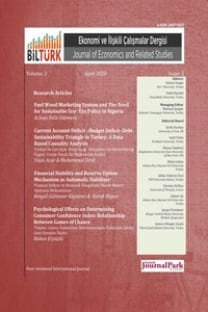The Relationships between Income Inequality & Savings: A Study on Households in Turkey
This study aims to investigate the relationship between income inequality and households in the Turkish economy. The issue of income inequality has gained increasing interest throughout the world in recent years. It is thought that the increasing importance of income inequality may be related to the economic growth performance of countries. It is observed that income inequality is high in the countries, which has a fluctuating trend of economic growth. Income inequality can affect economic growth through savings. Some of the savings in economies belong to households. Depending on the relationship between income levels and the marginal propensity of savings of households, economic growth performances of countries may vary. Therefore, income inequality is an important macroeconomic indicator for both developed and underdeveloped countries. In this study, the relationship between income inequality and savings for households in Turkey is analyzed with ARDL bound testing methodology. The findings of this study show that there is a long-term relationship between income inequality and savings.
Anahtar Kelimeler:
hane halkı, gelir eşitsizliği, tasarruflar
The Relationships between Income Inequality & Savings: A Study on Households in Turkey
This
study aims to investigate the relationship between income inequality and
households in the Turkish economy. The issue of income inequality has gained
increasing interest throughout the world in recent years. It is thought that
the increasing importance of income inequality may be related to the economic
growth performance of countries. It is observed that income inequality is high
in the countries, which has a fluctuating trend of economic growth. Income
inequality can affect economic growth through savings. Some of the savings in
economies belong to households. Depending on the relationship between income
levels and the marginal propensity of savings of households, economic growth
performances of countries may vary. Therefore, income inequality is an important
macroeconomic indicator for both developed and underdeveloped countries. In
this study, the relationship between income inequality and savings for
households in Turkey is analyzed with ARDL bound testing methodology. The findings of this study show that there is a long-term relationship between income
inequality and savings.
Keywords:
households, income inequality, savings,
___
Alam, I., & Quazi, R. (2003). Determinants of Capital Flight: An econometric case study of Bangladesh. International Review of Applied Economics , 85-103.Alan, S., Atalay, K., & Crossley, T. F. (2015). Do the rich save more? Evidence from Canada. The Review of Income and Wealth, 739-758.
Alvarez-Cuadrado, F., & Vilalta, M. E.-A. (2018). Income Inequality and Saving. Oxford Bulletin of Economics and Statistics, 1029-1061.
Blinder, A. (1975). Distribution effects and the aggregate consumption function. Journal of Political Economy, 608-626.
Bunting, D. (1991). Savings and Investment in a Global Economy. Journal of Post Keynesian Economics, 3-22.
Cook, C. (1995). Saving rates and income distribution: further evidence from LDC’s. Applied Economics, 71-82.
Della Valle, P., & Oguchi, N. (1976). Distribution, the aggregate consumption function, and the level of economic development: some cross-country results. Journal of Political Economy, 1325-1334.
Deniz, P., & Oztürkler, H., (2010). Effects of Income Inquality on Aggregate Saving: A Panel Analysis, Turgut Özal International Conference on Economics and Politics-I: Global Crises and Economic Governance, Malatya, Turkey, 15-16 April.
Duesenberry, J. S. (1949). Income, saving and the theory of consumer behaviour, Cambridge: Harvard University Press.
Dynan, K., Skinner, J., Zeldes, S. (1996). Do the rich save more?. Unpublished Manuscript.
Edwards, S. (1996). Why are Latin America’s saving rates so low? An International Comparative Analysis. Journal of Development Economics, 5-44.
Friedman, M. (1957). The Permanent Income Hypothesis, in M. Friedman ed. A Theory of Consumption Function. Princeton: Princeton University Press, 20-37.
Hong, K. (1995). Income distribution and aggregate saving, unpublished manuscript, Harvard University, Cambridge, MA.
Kaldor, N. (1957). A Model of Economic Growth. The Economic Journal, 591-624.
Lim, D. (1980). Income Distribution, export instability and savings behaviour. Economic Development and Cultural Change, 359-364.
Menchik, P., & David, M. (1983). Income distribution, lifetime savings and bequests. American Economic Review, 672-690.
Modigliani, F., & Brumberg, R. (1954). Utility Analysis and the Consumption Function: An Interpretation of Cross-Section Data, in K. Kurihara ed. The Collected Papers of Franco Modigliani. Cambridge: The MIT Press, 3-45.
Musgrove, P. (1980). Income distribution and the aggregate consumption function. Journal of Political Economy, 504-525.
Pasinetti, L. (1962). Rate of Profit and income distribution in relation to the rate of economic growth. Review of Economic Studies, 267-279.
Pesaran, M. H., Shin, Y., & Smith, R. J. (2001). Bound Testing Approaches to the Analysis of Level Relationships. Journal of Applied Econometrics, 289-326.
Sahota, G. (1993). Saving and distribution. In J. H. Gapinski ed., The Economics of Saving, Boston: Kluwer Academic Publishers, 193-231.
Schmidt-Hebbel, K., & Serven, L. (2000). Does income inequality raise aggregate saving? . Journal of Development Economics , 417-446.
Solow, R. (1956). A Contribution to the theory of economic growth. Quarterly Journal of Economics, 65-94.
Venieris, Y., & Gupta, D. (1986). Income distribution and sociopolitical instability as determinants of savings: a cross-sectional model. Journal of Political Economy, 873-883.
- Yayın Aralığı: Yılda 4 Sayı
- Başlangıç: 2019
- Yayıncı: Fatih DEYNELİ
Sayıdaki Diğer Makaleler
Economic Effects of Negative Interest Rate Policy Implementation
Terminology of Consumer Confidence Index
The Relationships between Income Inequality & Savings: A Study on Households in Turkey
The Causal Relationship between Stock Market Unemployment in Turkey
Book Review: Defence Economics
The Relationships between Income Inequality & Savings: A Study on Households in Turkey
